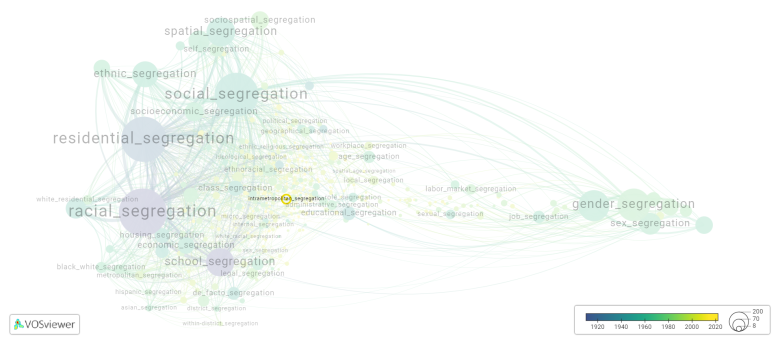Intrametropolitan segregation: Difference between revisions
(Creating page) |
(Creating page) |
||
| Line 24: | Line 24: | ||
[[File:intrametropolitan_segregation.png|780x780px]] | [[File:intrametropolitan_segregation.png|780x780px]] | ||
Visualization based on the [[How_to_cite_Segregation_Wiki| research]] | |||
For the complete network of associated segregation forms, see: | For the complete network of associated segregation forms, see: | ||
year of publication https://tinyurl.com/2235lkhw | * First year of publication https://tinyurl.com/2235lkhw | ||
Louvain clusters https://tinyurl.com/2d8wg5n3 | * Louvain clusters https://tinyurl.com/2d8wg5n3 | ||
* Betweenness centrality https://tinyurl.com/223udk5r | |||
* Disciplines where segregation forms first appeared https://tinyurl.com/244d8unz | |||
==References== | ==References== | ||
==Notes== | ==Notes== | ||
Revision as of 13:40, 3 October 2024
Date and country of first publication[1]
2021
United States
Definition
Intra metropolitan segregation refers to the spatial separation and concentration of different racial and ethnic groups within a metropolitan area. It is a phenomenon where certain neighborhoods or areas in a city have a higher concentration of one specific racial or ethnic group, while other neighborhoods are dominated by a different group.
Intra metropolitan segregation can occur due to a variety of factors, including historical patterns of racial and ethnic discrimination, socioeconomic disparities, and individual preferences for living near people who share a similar cultural background.
This type of segregation can have significant social, economic, and political implications. It can contribute to unequal access to quality education, healthcare, and job opportunities for certain racial and ethnic groups. It can also contribute to the perpetuation of stereotypes and biases, as well as hinder social interaction and understanding between different groups.
Efforts to address intra-metropolitan segregation often involve policies and initiatives aimed at promoting fair housing practices, encouraging diverse and inclusive neighborhoods, and providing equal opportunities for all residents within a metropolitan area.
Synonyms
The following terms are synonymous with:
intra metropolitan segregation.
References and literature addressing this segregation form under these synonymous terms can be found below.
See also
Related segregation forms
Intrametropolitan segregation is frequently discussed in the literature with the following segregation forms:
Visualization based on the research
For the complete network of associated segregation forms, see:
- First year of publication https://tinyurl.com/2235lkhw
- Louvain clusters https://tinyurl.com/2d8wg5n3
- Betweenness centrality https://tinyurl.com/223udk5r
- Disciplines where segregation forms first appeared https://tinyurl.com/244d8unz
References
Notes
- ↑ Date and country of first publication as informed by the Scopus database (December 2023).
At its current state, this definition has been generated by a Large Language Model (LLM) so far without review by an independent researcher or a member of the curating team of segregation experts that keep the Segregation Wiki online. While we strive for accuracy, we cannot guarantee its reliability, completeness and timeliness. Please use this content with caution and verify information as needed. Also, feel free to improve on the definition as you see fit, including the use of references and other informational resources. We value your input in enhancing the quality and accuracy of the definitions of segregation forms collectively offered in the Segregation Wiki ©.
Intrametropolitan segregation appears in the following literature
Hashimoto Y. (2021). Racing the creative class: diversity, racialized discourses of work, and colorblind redevelopment. Urban Geography, 42(4), 528-550. Routledge.https://doi.org/10.1080/02723638.2020.1731180

